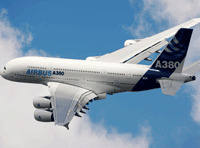
Checks reveal more cracks in A380 wing part
Dubai, January 25, 2012
Airbus faces more potential discomfort on the A380 superjumbo after industry sources said inspections ordered by European authorities had revealed the existence of more cracks on a wing component.
The European planemaker insists the world's largest passenger jet remains safe to fly, but the disclosure of further cracks on even a handful of wing components could delay efforts to end a sequence of niggling concerns over its performance.
European safety authorities ordered urgent inspections on just under a third of the superjumbo fleet last week after two types of cracks were discovered within weeks of each of other on the same type of part, an L-shaped bracket inside the wing.
Since then, similar cracks have been found inside the 9,100-square-foot wing of at least one of the superjumbos examined under the directive, industry sources told Reuters.
The latest findings came as it emerged that cracks on a bracket in another part of the wing were discovered two years ago. The problem was documented at the time but went unnoticed outside the industry.
Airbus insisted on Tuesday this was a different issue from the latest flaws and had been resolved. There are 2,000 brackets in each wing, which is constructed around a rib cage and attached to the wing's skeleton with brackets known as rib feet.
The most recent cracks surfaced in this type of bracket.
The crack spotted in 2010 showed up on a bracket in part of the wing specially designed to help the huge airliner climb more steeply at take-off and obey noise restrictions.
The original incident triggered compulsory checks in October 2010, but was dwarfed by the blowout of an engine on a Qantas A380 a few weeks later, which made global headlines.
This began a chain of events still being felt today.
It was during $130 million repairs -- lasting more than a year -- to the stricken Qantas airliner that the cracked rib feet were discovered. This in turn led to the discovery of a second and potentially more significant type of crack on the same type of bracket, triggering this week's inspections.
The checks affect some 20 aircraft operated by Singapore Airlines, Dubai's Emirates and Air France, making up just under a third of the current A380 fleet.
Airlines have until Friday to complete a first phase of tests for the most heavily used category of aircraft, with at least 1,800 take-offs and landings.
Airbus and Boeing are governed by directives issued regularly by the US Federal Aviation Administration (EASA).
Singapore Airlines, which was the first airline to introduce the A380 in December 2007, said inspections were underway on six aircraft covered by Friday's deadline.
'We will have a better overview of any findings upon completing the checks,' a spokeswoman said.
Airbus declined to comment on any interim results but a spokesman said recent events showed that the industry's process of continuous evaluation, designed to catch and repair any faults before they become a hazard, was working smoothly.
'We have clear evidence that the airworthiness process is working,' a spokesman for the EADS subsidiary said.
'An issue has been found, we reported it, we made a recommendation to our customers, EASA made it mandatory and the and the inspection and fix if necessary are both under way'.
An Australian aircraft engineers' union has called on Airbus to ground all A380s, which sell for $390 million each.
Airbus and the European Aviation Safety Agency say the A380 remains safe to fly, but EASA also says that if left unchecked, the cracks could affect the jet's structural integrity.
Developers say all aircraft have teething problems and most eventually develop cracks but experts can chart the number of directives to tell whether a model is a cause for concern.
A new aircraft will tend to generate more directives as a result of initial glitches and an older type will attract extra attention due to metal fatigue, with a plateau in between.
An EASA spokesman said the A380 was producing fewer bulletins than a normal aircraft of its age.
Airbus is however keen to avoid any further embarrassment and to allay concerns over its flagship aircraft.
The UK-designed and -manufactured wings, easily large enough for an adult to stand inside, where they join the fuselage, are the largest ever developed for a civilian passenger jet.
The A380 was developed in France, Germany, Britain and Spain at an estimated cost of 12 billion euros to compete with the Boeing 747 and establish Airbus as a challenger at the top end of the market, but has hit a series of production delays.
Airbus has sold 253 of the aircraft and 68 are in service.-Reuters







